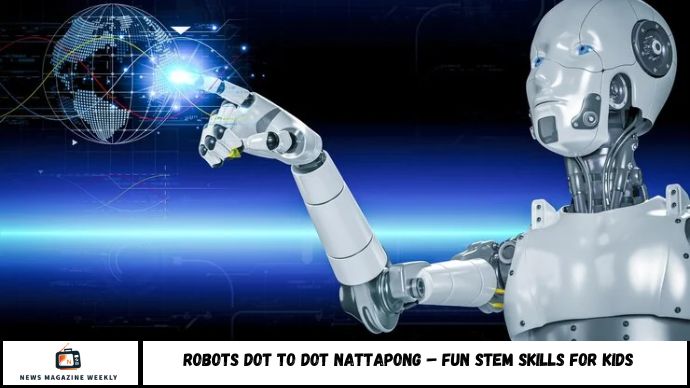Robots Dot to Dot Nattapong is an innovative, engaging educational activity that helps children develop STEM skills through fun dot-connecting puzzles. This article explains how it works, its benefits, and why it’s an ideal learning tool for kids aged 6 to 12.
Robots Dot to Dot Nattapong is a creative activity where participants connect numbered dots to reveal imagesoften featuring robotic designs or themes. It blends classic puzzle-solving and drawing with elements of robotics, offering an engaging, hands-on experience. These activities can be delivered through printable worksheets, interactive apps, or even physical setups where robots assist in completing the images, adding an extra layer of interactivity and learning.
Introduction: Can Learning Really Be This Fun?
In an age where screens dominate a child’s attention, many parents and educators are searching for activities that engage young minds without mindless scrolling. Robots Dot to Dot Nattapong offers a creative solution by transforming simple dot-to-dot puzzles into interactive, STEM-rich experiences.
Combining artistic fun with critical thinking, this activity encourages children to think like engineers while enjoying the process. In this article, we’ll explore what makes Robots Dot to Dot Nattapong an excellent tool for developing early STEM skills, how it works, and why it’s gaining popularity among both parents and teachers.
What Is Robots Dot to Dot Nattapong?
Robots Dot to Dot Nattapong is a unique series of educational puzzles where children connect numbered dots to create robot illustrations. But it goes beyond basic dot-to-dot worksheets. Each robot introduces new problem-solving challenges, promoting logic, sequencing, and fine motor skills.
The puzzles gradually increase in complexity. Early versions may use simple numbers (1–20), while advanced designs may include patterns or math-based connections, introducing the kind of logical structure found in coding and robotics.
How It Supports STEM Learning
1. Develops Logical Thinking
Children must follow sequential patterns and anticipate the next steps, building logical reasoning that aligns with how computers and robots operate.
2. Builds Focus and Patience
Completing each puzzle requires attention to detail and concentration, skills essential in both academics and everyday life.
3. Introduces Engineering Concepts
By assembling robot figures through dot patterns, children learn the idea that individual parts come together to form a functional whole—an essential principle in engineering and robotics.
Key Benefits for Children
- Encourages problem-solving through visual and cognitive challenges
- Reinforces number recognition and sequencing
- Balances creativity with structure
- Ideal for both independent learning and classroom settings
- Reduces screen dependence through printable formats
Supporting Data and Trends
- A 2024 report by LEGO Education found that 78% of teachers saw improved focus and logic when students engaged with hands-on STEM tools.
- According to Statista, the educational puzzle market is expected to grow at an 8.7% CAGR between 2024 and 2028.
- A 2025 Parenting Tech Survey revealed that 82% of parents prefer low-screen, logic-based activities over video-based apps for children under 12.
These findings suggest that tools like Robots Dot to Dot Nattapong are more than just fun—they are effective and in demand.
How to Use Robots Dot to Dot Nattapong Effectively
- Start Simple: Begin with lower-numbered dot puzzles to build confidence.
- Integrate with Lessons: Use puzzles during math or logic sessions in classrooms.
- Print or Project: Offer both printable worksheets and digital projections for different learning environments.
- Encourage Creativity: Let children color and customize their robot creations after completion.
- Track Progress: Create a visual chart showing completed puzzles to keep children motivated.
FAQs
1. What age group is it best suited for?
Most appropriate for children aged 6–12, depending on puzzle complexity.
2. Is it a digital or printable activity?
It can be both. Some formats are interactive, while others are downloadable printables.
3. Does it actually teach STEM concepts?
Yes. It introduces logic, sequencing, problem-solving, and basic engineering thinking.
4. Is it free or paid?
Many basic versions are free; some advanced puzzle sets may require a purchase.
5. Can teachers use this in classrooms?
Absolutely. It’s excellent for quiet workstations or integrated STEM units.
6. Where can I find these puzzles?
Look on educational platforms like Teachers Pay Teachers, Etsy, or through direct creators online.
Conclusion
Robots Dot to Dot Nattapong offers a simple yet powerful way to bridge the gap between fun and learning. It combines the joys of puzzle-solving with core STEM principles, making it ideal for children, parents, and teachers seeking more meaningful educational tools.
Whether used at home or in school, this activity encourages creativity, patience, and analytical thinking in a format kids love.

